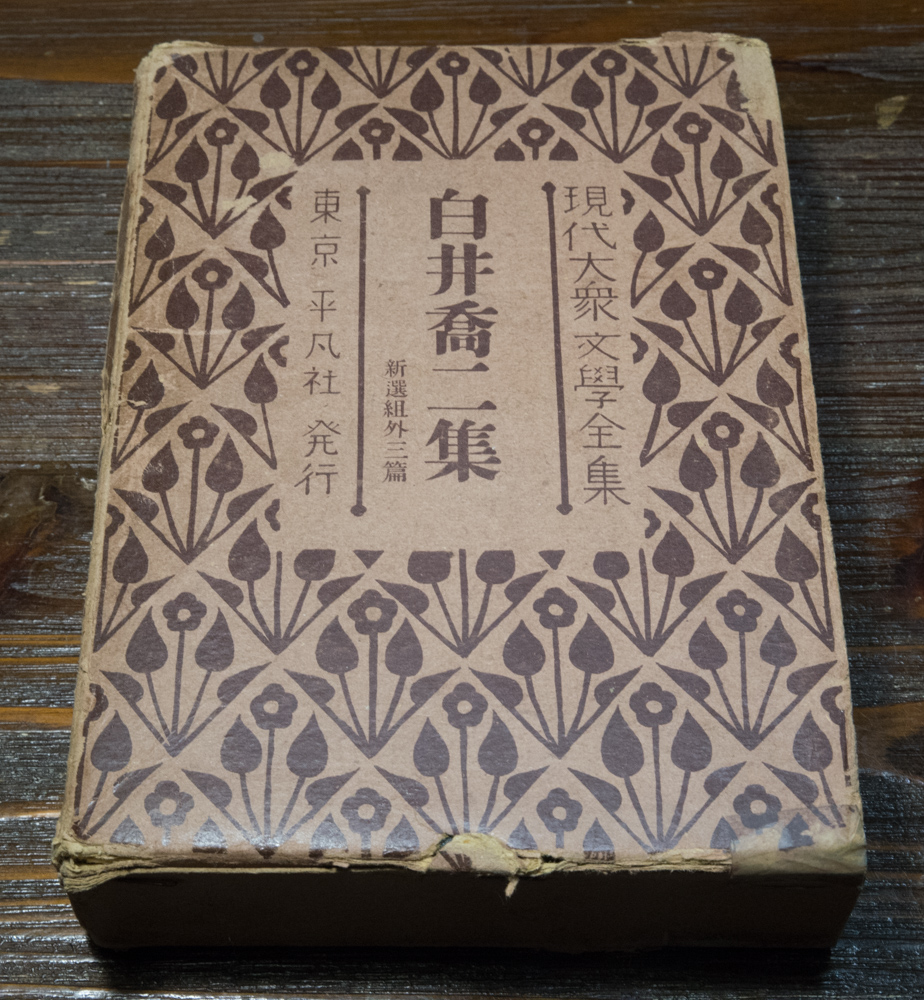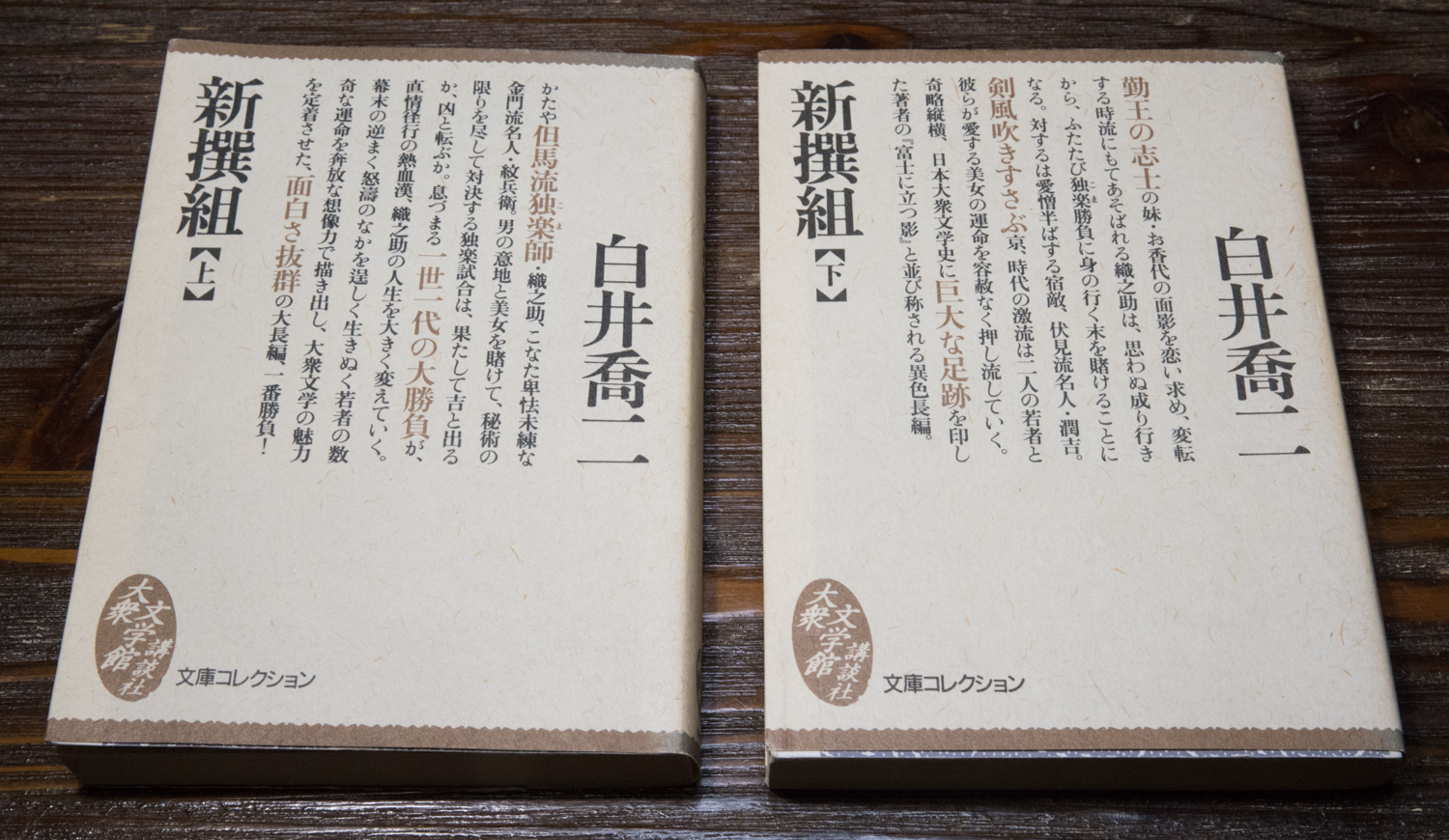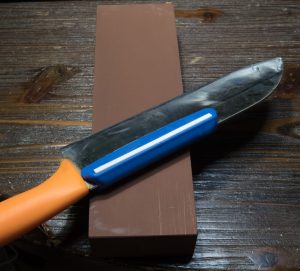

Shinsen-gumi was serialized from 1924 through 1925 on a weekly magazine “Sunday Mainichi”. Sunday Mainichi was published by Mainichi Newspapers Co., Ltd as the first weekly magazine in Japan. As the name shows, the magazine was first published as a Sunday issue of Mainichi newspaper. Since the distinction between normal newspaper and this weekly magazine was not clear for many readers, the number of prints remained stagnant in the early stage. The publisher then tried to make the contents of this weekly magazine clearly different from daily newspapers and it placed Kyoji’s new romance on the top of the magazine. It was a kind of gamble for the publisher, but very interesting stories of Kyoji’s novel attracted many new readers and the financial status of the magazine was thoroughly stabilized.
Another important topic related to this romance is that it was put in the first volume of the Heibonsha’s complete set of public romances, to which Kyoji committed himself very much. The fact that 330 thousands copies were sold for the first volume brought a big success to this set.
Shinsen-gumi was a group of Samurai warriors who guarded Kyoto under the authority of the Tokugawa Shogun regime from around 1863 through 1867. Many members of Shinsen-gumi took rather violent and brutal ways to guard Kyoto and killed many pro-Imperialists by their Japanese swords. Shinsen-gumi was one of the most favored topics for many novelists of public romance at that time.
Kyoji, however, did not write an usual story related to Shinsen-gumi. The story of the romance was mostly of battles between three different schools of spinning tops. Spinning tops were not only toys for kids but also a genre of street performance in Japan. A school of spinning tops here means combination of street performers and meister-level artisans. The first battle was between Orinosuke of Tajimaryu school and Monbee of Kinmonryu school. In this battle, two beautiful ladies were the prize of the battle, and the lady of the lost side had to be gifted to a foreign merchant. The second battle was between Orinosuke and Inosuke of Fushimiryu in Kyoto. In the second battle, both participants tried to get the heart of a lady.
These battels of spinning tops described in this romance were technically very deep and enthusiastic. For example, the both sides selected very special types of wood for their tops and the battle started from guessing which type of wood the counterpart selected. Orinosuke used one very special wood growing on the Nokogiri-yama mountain in Chiba, while Monbee selected one growing on Ontake mountain in Nagano. The Monbee’s top could generate strange wind while it spins trying to weaken the rotation of the counterpart’s top. The Orinosuke’s top, however, was not affected by the wind from the Monbee’s top, since he used a special wood growing on Nokogiri-yama mountain. (It means that Monbee failed to presume the type of wood used for the Orinosuke’s top). This kind of “professional” battles between two craft-persons attracted the then readers much and made them excited.
On the contrary to the battles of tops, Shinsen-gumi plays only in the background of the stories. Orinosuke witnessed the famous Ikedaya incident in which Shisen-gumi killed many famous pro-Imperialists. Kyoji developed a new way of fights between appearing characters in a romance other than sword battles (Chambara). This can be compared to the fact that he adopted a battle by debates in Fuji ni tatsu Kage.
The impression of this romance to the readers was tremendous and people requested Kyoji to write another romance of this type and it distressed Kyoji later for a long period, since he was thinking that he was always trying to change his styles and did not want to stay at the same stage.
日: 2018年11月3日
包丁研ぎ
 家で包丁を使うのは、今は基本的にリンゴ・柿・梨などの果物の皮を剥くときだけですが(私は子供の時亡母に教わったし、実際に小学生の時は朝食を作っていたりした関係で、それなりに果物の皮を剥くのはそこらの若い女性より多分うまいです)、何故か包丁の切れ味には凝っていて、現在砥石3種(荒砥、中砥、仕上げ砥)と、その砥石が平らでなくなった時に使う砥石を研ぐ砥石と、その時砥石に振りかける人造ダイヤモンドの粉まで持っています。
家で包丁を使うのは、今は基本的にリンゴ・柿・梨などの果物の皮を剥くときだけですが(私は子供の時亡母に教わったし、実際に小学生の時は朝食を作っていたりした関係で、それなりに果物の皮を剥くのはそこらの若い女性より多分うまいです)、何故か包丁の切れ味には凝っていて、現在砥石3種(荒砥、中砥、仕上げ砥)と、その砥石が平らでなくなった時に使う砥石を研ぐ砥石と、その時砥石に振りかける人造ダイヤモンドの粉まで持っています。
と道具に凝るのはいいですが、なかなか「丸研ぎ」といわれる角度が不均一な研ぎから脱却出来ていません。要するに研ぐときに刃物を砥石に当てる角度を一定にする、ということです。この角度は万能包丁の場合15°くらいみたいですが、私はこの角度に保ってくれる当て板みたいなのがないかと思って探してみましたが見つかりませんでした。素人の「丸研ぎ」でも、まったく研がないよりは切れ味は向上しますが、結局その切れ味が均一ではなくムラが出ます。Webで調べると、丸研ぎにならないこつは、
(1)包丁を砥石に対し斜めに当てて、包丁と砥石が一度に接触する部分を増やす。
(2)あわてずに、ゆっくり角度を保つようにして研ぐ
(3)砥石がすり減っている場合にはまっすぐに面を直す(このために砥石を研ぐ砥石が必要です。)
(3)については、昔「味いちもんめ」という漫画で、自転車の後ろに紐で砥石をくっつけて引っ張って、アスファルトの面で砥石を研磨する、というのが出てきましたが、その方法は危険ですし、また砥石が均一に平らになる保証もありません。
ということで、今回念のためもう一度角度を保つ当て板みたいなものがないか探してみたら、何と複数の会社から出ていました。早速Amazonで注文して取り寄せました。早速使って研いでみましたが、なかなかいいです!角度そのものは私が思っていたよりも大きい感じでした。治具が砥石とすれて邪魔になるんじゃないかと思われる方があると思いますが、接触する部分はセラミックになっていて簡単にすり減らないようになっています。また研ぐ時に邪魔になる感じもあまりありません。却って束に近い方を研ぐ時はこれまで束が砥石に当たってうまく研げませんでしたが、この治具付けるといい感じになります。
ただ、この治具はあくまでも一般的な洋包丁の万能包丁向けだと思います。刃も薄く、また刃の高さもあまりない包丁などをこれを使って研ぐと角度が正しくなくなると思います。
